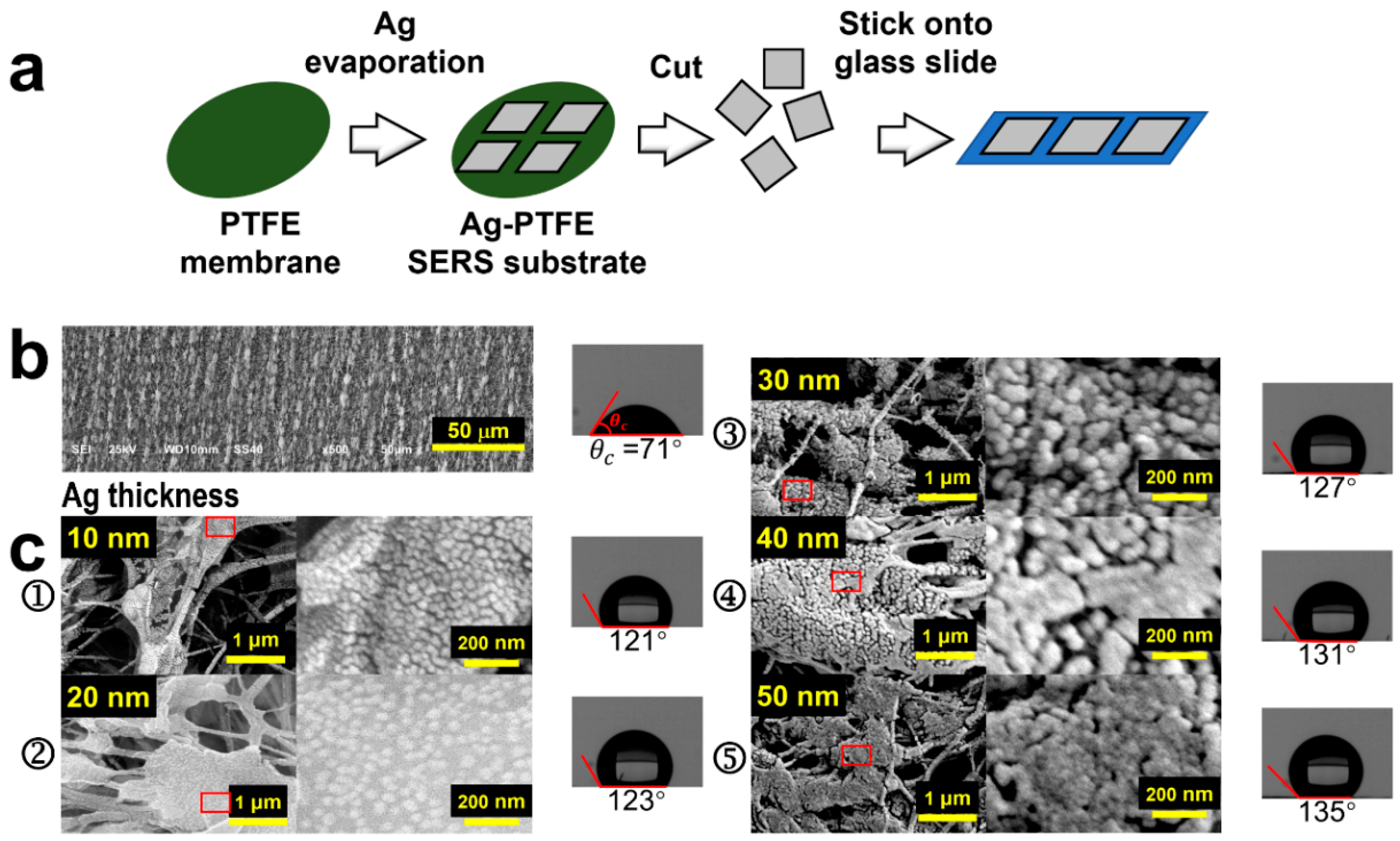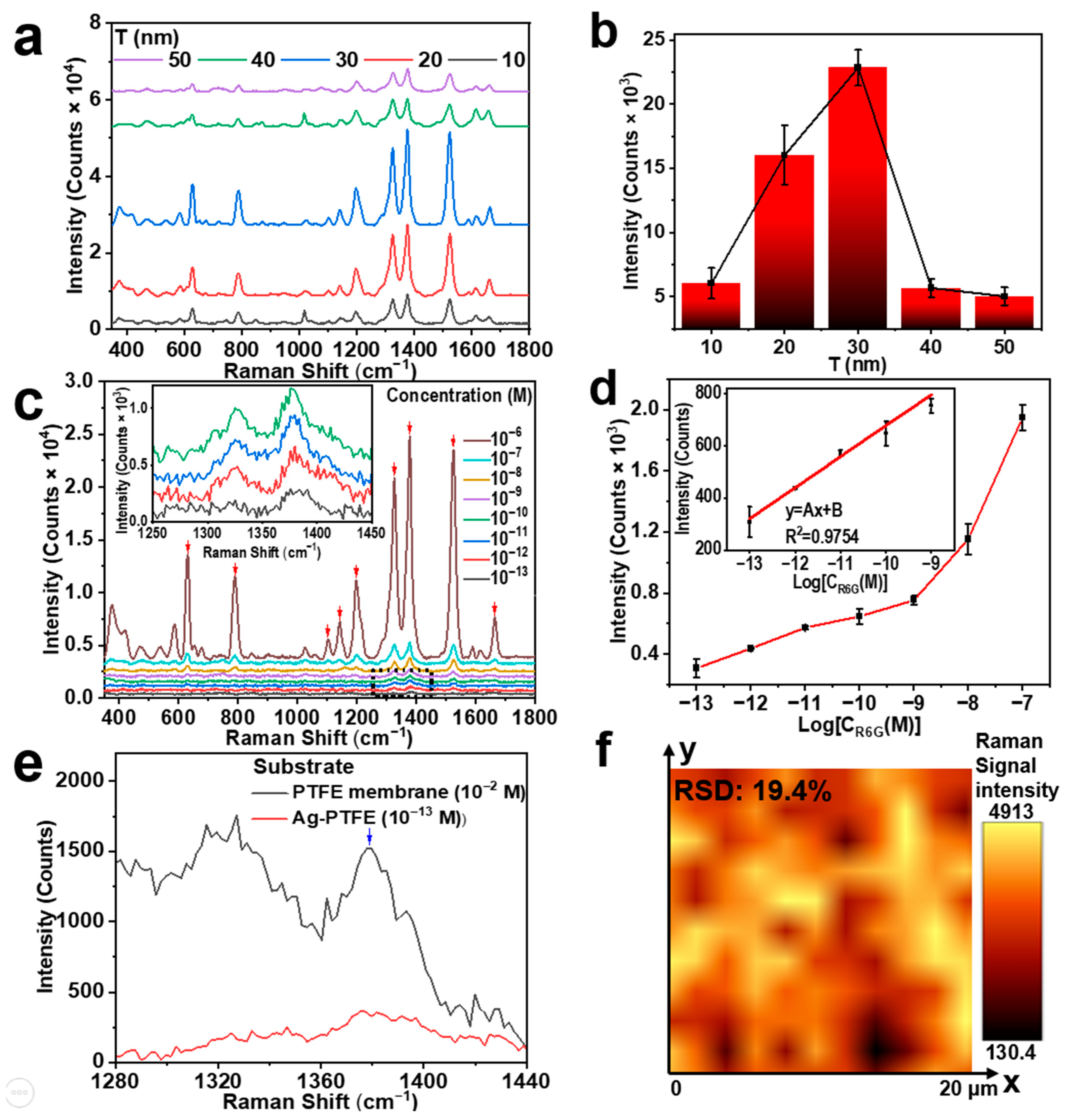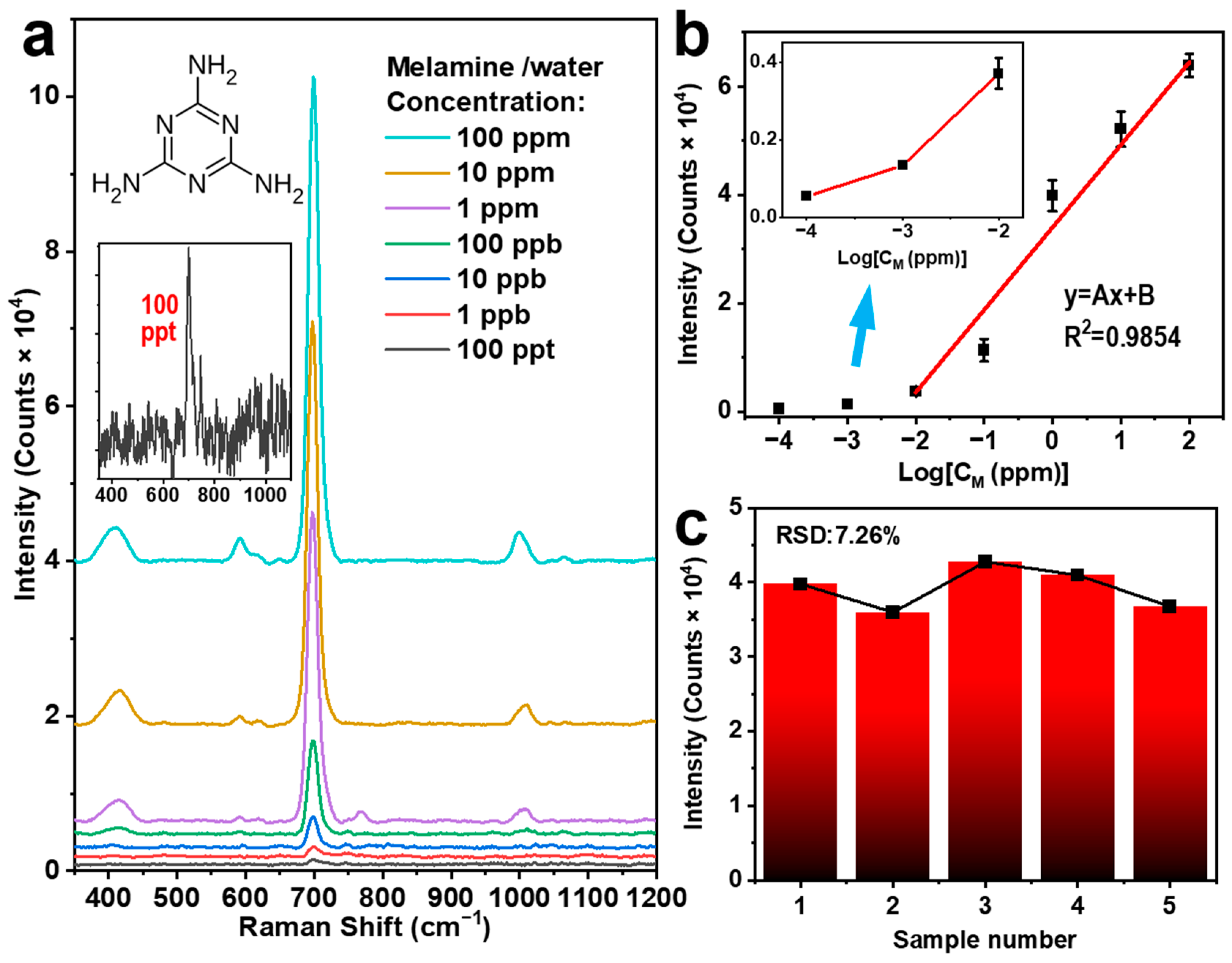A Three-Dimensional Hydrophobic Surface-Enhanced Raman Scattering Sensor via a Silver-Coated Polytetrafluoroethylene Membrane for the Direct Trace Detection of Molecules in Water
Abstract
1. Introduction
2. Construction and Characterization of the Ag-PTFE SERS Sensor
3. Optimization of the SERS Performance by the Ag-Coated PTFE Membrane
4. Detection of Melamine in Water
5. Conclusions
6. Experimental Methods
6.1. Materials and Regents
6.2. Characterizations
6.3. Detection of R6G Molecules in Water
6.4. Detection of Melamine Molecules in Water
Supplementary Materials
Author Contributions
Funding
Institutional Review Board Statement
Informed Consent Statement
Data Availability Statement
Acknowledgments
Conflicts of Interest
References
- Fleischmann, M.; Hendra, P.J.; McQuillan, A.J. Raman spectra of pyridine adsorbed at a silver electrode. Chem. Phys. Lett. 1974, 26, 163–166. [Google Scholar] [CrossRef]
- Jeanmaire, D.L.; Duyne, R.P.V. Surface raman spectroelectrochemistry: Part I. heterocyclic, aromatic, and aliphatic amines adsorbed on the anodized silver electrode. J. Electroanal. Chem. Interfacial Electrochem. 1977, 84, 1–20. [Google Scholar] [CrossRef]
- Wei, S.Q.; Li, L.; Gou, L.C.; Wu, L.; Hou, X.D. Thiol-ene click derivatization reaction coupled with ratiometric surface-enhanced raman scattering for reproducible and accurate determination of acrylamide. Food Chem. 2023, 429, 136991. [Google Scholar] [CrossRef] [PubMed]
- Ilyas, A.; Dyussupova, A.; Sultangaziyev, A.; Shevchenko, Y.; Filchakova, O.; Bukasov, R. SERS immuno- and apta-assays in biosensing/bio-detection: Performance comparison, clinical applications, challenges. Talanta 2023, 265, 124818. [Google Scholar] [CrossRef]
- Awada, C.; Hammud, H.H.; Bukhamsin, H.A.; Al-Hudairi, D.E.; Ruffino, F. Development of ultrasensitive new sensors based on thio-functionalized heterogeneous layers of gold/graphene/copper for glucose detection. Appl. Surf. Sci. 2023, 638, 158012. [Google Scholar] [CrossRef]
- Cai, J.H.; Lin, Y.J.; Yu, X.W.; Yang, Y.Q.; Hu, Y.Q.; Gao, L.L.; Xiao, H.C.; Du, J.R.; Wang, H.N.; Zhong, X.; et al. Multifunctional AuAg-doping prussian blue-based MOF: Enhanced colorimetric catalytic activities and amplified SERS signals for bacteria discrimination and detection. Sens. Actuators B 2023, 394, 134279. [Google Scholar] [CrossRef]
- Aravind, P.K.; Nitzan, A.; Metiu, H. The interaction between electromagnetic resonances and its role in spectroscopic studies of molecules adsorbed on colloidal particles or metal spheres. Surf. Sci. 1981, 110, 189–204. [Google Scholar] [CrossRef]
- Huebner, U.; Boucher, R.; Schneidewind, H.; Cialla, D.; Popp, J. Microfabricated SERS-arrays with sharp-edged metallic nanostructures. Microelectron. Eng. 2008, 85, 1792–1794. [Google Scholar] [CrossRef]
- Shanthil, M.; Thomas, R.; Swathi, R.S.; Thomas, K.G. Ag@SiO2 core–shell nanostructures: Distance-dependent plasmon coupling and SERS investigation. J. Phys. Chem. Lett. 2012, 3, 1459–1464. [Google Scholar] [CrossRef]
- McMahon, J.M.; Li, S.Z.; Ausman, L.K.; Schatz, G.C. Modeling the effect of small gaps in surface-enhanced raman spectroscopy. J. Phys. Chem. C 2012, 116, 1627–1637. [Google Scholar] [CrossRef]
- Liu, Z. One-step fabrication of crystalline metal nanostructures by direct nanoimprinting below melting temperatures. Nat. Commun. 2017, 8, 14910. [Google Scholar] [CrossRef]
- Huang, Z.L.; Meng, G.W.; Hu, X.Y.; Pan, Q.J.; Huo, D.X.; Zhou, H.J.; Ke, Y.; Wu, N.Q. Plasmon-tunable Au@Ag core-shell spiky nanoparticles for surface-enhanced raman scattering. Nano Res. 2019, 12, 449–455. [Google Scholar] [CrossRef]
- Brancato, A.; Condorelli, M.; Salemi, L.; Scardaci, V.; Fragalà, M.; Barcellona, M.; Compagnini, G.; D’Urso, L. Ag nanoflowers as single-particle, multi-wavelength SERS active platforms. Surf. Interfaces 2023, 40, 103157. [Google Scholar] [CrossRef]
- Basavaraja, B.M.; Bantwal, R.P.; Tripathi, A.; Hegde, G.; John, N.S.; Thapa, R.; Hegde, G.; Balakrishna, R.G.; Saxena, M.; Altaee, A.; et al. Functionalized silver nanocubes for the detection of hazardous analytes through surface-enhanced raman scattering: Experimental and computational studies. ACS Sustain. Chem. Eng. 2023, 11, 10605–10619. [Google Scholar] [CrossRef]
- Tan, Y.Y.; Qi, M.Y.; Jiang, H.; Wang, B.H.; Zhang, X. Determination of uric acid in serum by SERS system based on VO-MnCo2O4/Ag nanozyme. Anal. Chim. Acta 2023, 1274, 341584. [Google Scholar] [CrossRef]
- Yu, D.X.; Xu, L.; Zhang, H.Z.; Li, J.; Wang, W.; Yang, L.B.; Jiang, X.; Zhao, B. A new semiconductor-based SERS substrate with enhanced charge collection and improved carrier separation: CuO/TiO2 p-n heterojunction. Chin. Chem. Lett. 2023, 34, 107771. [Google Scholar] [CrossRef]
- Zhao, H.Y.; Jin, J.; Tian, W.J.; Li, R.; Yu, Z.; Song, W.; Cong, Q.; Zhao, B.; Ozaki, Y. Three-dimensional superhydrophobic surface-enhanced raman spectroscopy substrate for sensitive detection of pollutants in real environments. J. Mater. Chem. A 2015, 3, 4330–4337. [Google Scholar] [CrossRef]
- Lin, H.Y.; Chen, W.R.; Lu, L.C.; Chen, H.L.; Chen, Y.H.; Pan, M.; Chen, C.C.; Chen, C.; Yen, T.H.; Wan, D.H. Direct thermal growth of gold nanopearls on 3D interweaved hydrophobic fibers as ultrasensitive portable SERS substrates for clinical applications. Small 2023, 19, 2207404. [Google Scholar] [CrossRef] [PubMed]
- Cao, J.R.; Huang, Y.L.; Shang, Z.Y.; Liu, X.; Lu, C.Y.; Chen, H.P.; Liang, P.; Ma, G.C. Fabrication of core shell Au@Ag supraparticles with 3D hotspots via evaporation self-assembly for sensitive surface enhanced raman scattering detection. Sens. Actuators B 2023, 382, 133529. [Google Scholar] [CrossRef]
- Sakir, M.; Yilmaz, E.; Onses, M.S. SERS-active hydrophobic substrates fabricated by surface growth of Cu nanostructures. Microchem. J. 2020, 154, 104628. [Google Scholar] [CrossRef]
- Wang, L.M.; Womiloju, A.A.; Höppener, C.; Schubert, U.S.; Hoeppener, S. On the stability of microwave-fabricated SERS substrates—Chemical and morphological considerations. Beilstein J. Nanotechnol. 2021, 12, 541–551. [Google Scholar] [CrossRef] [PubMed]
- Mu, Y.Y.; Zhang, X.P. A paper-fiber-supported 3D SERS substrate. Plasmonics 2020, 15, 889–896. [Google Scholar] [CrossRef]
- Zhao, P.N.; Liu, H.Y.; Zhang, L.N.; Zhu, P.H.; Ge, S.G.; Yu, J.H. Paper-Based SERS Sensing Platform Based on 3D Silver Dendrites and Molecularly Imprinted Identifier Sandwich Hybrid for Neonicotinoid Quantification. ACS Appl. Mater. Interfaces 2020, 12, 8845–8854. [Google Scholar] [CrossRef] [PubMed]
- Wall, M.A.; Harmsen, S.; Pal, S.; Zhang, L.H.; Arianna, G.; Lombardi, J.R.; Drain, C.M.; Kircher, M.F. Surfactant-Free Shape Control of Gold Nanoparticles Enabled by Unified Theoretical Framework of Nanocrystal Synthesis. Adv. Mater. 2017, 29, 1605622. [Google Scholar] [CrossRef]
- Gilic, M.; Ghobara, M.; Reissig, L. Tuning SERS Signal via Substrate Structuring: Valves of Different Diatom Species with Ultrathin Gold Coating. Nanomaterials 2023, 13, 1594. [Google Scholar] [CrossRef] [PubMed]
- Lin, W.; Yang, L.K.; Cai, S.; Zhu, J.; Feng, Y.; Yang, L.X.; Feng, Z.Z.; Li, P.P.; Chen, J.H.; Wang, Y.H. Cognitive function and biomarkers after traumatic brain injury: Protocol for a prospective inception cohort study. Asia Pac. J. Clin. Trials Nerv. Syst. Dis. 2016, 1, 170. [Google Scholar]
- Li, J.; Qi, H.Y.; Shi, Y.P. Determination of melamine residues in milk products by zirconia hollow fiber sorptive microextraction and gas chromatography–mass spectrometry. J. Chromatogr. A 2009, 1216, 5467–5471. [Google Scholar] [CrossRef]
- Guedes-Alonso, R.; Sosa-Ferrera, Z.; Santana-Rodríguez, J.J. Determination of steroid hormones in fish tissues by microwave-assisted extraction coupled to ultra-high performance liquid chromatography tandem mass spectrometry. Food Chem. 2017, 237, 1012–1020. [Google Scholar] [CrossRef]
- Zhang, Y.H.; Zhao, W.D.; Wang, D.Z.; Zhang, H.T.; Chai, G.B.; Zhang, Q.D.; Lu, B.B.; Sun, S.H.; Zhang, J.X. Direct analysis of carbonyl compounds by mass spectrometry with double-region atmospheric pressure chemical ionization. Anal. Chem. 2019, 91, 5715–5721. [Google Scholar] [CrossRef]
- Lu, Y.; Xia, Y.Q.; Liu, G.Z.; Pan, M.F.; Li, M.J.; Lee, N.J.A.; Wang, S. A review of methods for detecting melamine in food samples. Crit. Rev. Anal. Chem. 2017, 47, 51–66. [Google Scholar] [CrossRef]
- Bormashenko, E.; Bormashenko, Y.; Whyman, G.; Pogreb, R.; Stanevsky, O. Micrometrically scaled textured metallic hydrophobic interfaces validate the Cassie–Baxter wetting hypothesis. J. Colloid Interface Sci. 2006, 302, 308–311. [Google Scholar] [CrossRef]
- Skriver, H.L.; Rosengaard, N.M. Surface energy and work function of elemental metals. Phys. Rev. B 1992, 46, 7157–7168. [Google Scholar] [CrossRef] [PubMed]
- Kaganer, V.M.; Jenichen, B.; Shayduk, R.; Braun, W.; Riechert, H. Kinetic optimum of volmer-weber growth. Phys. Rev. Lett. 2009, 102, 016103. [Google Scholar] [CrossRef] [PubMed]
- Owens, D.K.; Wendt, R.C. Estimation of the surface free energy of polymers. J. Appl. Polym. Sci. 1969, 13, 1741–1747. [Google Scholar] [CrossRef]
- Tiwari, M.; Singh, A.; Dureja, S.; Basu, S.; Pattanayek, S.K. Au nanoparticles decorated ZnO/ZnFe2O4 composite SERS-active substrate for melamine detection. Talanta 2022, 236, 122819. [Google Scholar] [CrossRef]
- Gokulakrishnan, J.; Manojkumar, P.A.; Koppole, K. Surfactant-Free Facile Synthesis of Ag/rGO Nanohybrid for SERS-Based Detection of Melamine. Plasmonics 2023. [Google Scholar] [CrossRef]
- Lee, C.H.; Tsai, C.H.; Lin, D.Z. Optimization of physical vapor deposition process for low background nanoimprinted SERS substrate in quantitative melamine analysis. Spectrochim. Acta Part A Mol. Biomol. Spectrosc. 2024, 306, 123563. [Google Scholar]



Disclaimer/Publisher’s Note: The statements, opinions and data contained in all publications are solely those of the individual author(s) and contributor(s) and not of MDPI and/or the editor(s). MDPI and/or the editor(s) disclaim responsibility for any injury to people or property resulting from any ideas, methods, instructions or products referred to in the content. |
© 2024 by the authors. Licensee MDPI, Basel, Switzerland. This article is an open access article distributed under the terms and conditions of the Creative Commons Attribution (CC BY) license (https://creativecommons.org/licenses/by/4.0/).
Share and Cite
Tao, G.; Li, J.; Mu, Y.; Zhang, X. A Three-Dimensional Hydrophobic Surface-Enhanced Raman Scattering Sensor via a Silver-Coated Polytetrafluoroethylene Membrane for the Direct Trace Detection of Molecules in Water. Biosensors 2024, 14, 88. https://doi.org/10.3390/bios14020088
Tao G, Li J, Mu Y, Zhang X. A Three-Dimensional Hydrophobic Surface-Enhanced Raman Scattering Sensor via a Silver-Coated Polytetrafluoroethylene Membrane for the Direct Trace Detection of Molecules in Water. Biosensors. 2024; 14(2):88. https://doi.org/10.3390/bios14020088
Chicago/Turabian StyleTao, Guanwei, Jiajun Li, Yunyun Mu, and Xinping Zhang. 2024. "A Three-Dimensional Hydrophobic Surface-Enhanced Raman Scattering Sensor via a Silver-Coated Polytetrafluoroethylene Membrane for the Direct Trace Detection of Molecules in Water" Biosensors 14, no. 2: 88. https://doi.org/10.3390/bios14020088
APA StyleTao, G., Li, J., Mu, Y., & Zhang, X. (2024). A Three-Dimensional Hydrophobic Surface-Enhanced Raman Scattering Sensor via a Silver-Coated Polytetrafluoroethylene Membrane for the Direct Trace Detection of Molecules in Water. Biosensors, 14(2), 88. https://doi.org/10.3390/bios14020088






